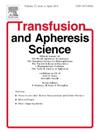Comparative assessment of hemostasis in septic patients and healthy controls using standard coagulation tests and whole-blood thromboelastometry
IF 1.4
4区 医学
Q4 HEMATOLOGY
引用次数: 0
Abstract
Background
Sepsis is associated with dysregulation of procoagulant, anticoagulant, and fibrinolytic pathways.
Aims
To compare the measurements of coagulation activation, clot formation, stabilization, and lysis between rotational thromboelastometry (ROTEM) and standard coagulation tests (SCTs) on patients with early sepsis (SP) and healthy controls (HC).
Methods
This observational study included 30 SP and 30 HC. At study inclusion, SCTs and ROTEM analyses were conducted. A modified ROTEM with exogenous tPA was used to investigate fibrinolysis resistance.
Results
SP had longer prothrombin time, higher fibrinogen levels and lower platelet count compared to HC. On ROTEM, clotting initiation was longer in SP than in HC but median clotting time maintained within reference ranges. SP had higher maximum velocity of clot formation, clot firmness, elasticity, and platelet component than HC. Clot lysis indices (CLI) were higher in EXTEM and APTEM (without and with added tPA) in SP compared to HC. The difference in CLI between APTEM and EXTEM was lower for both native and tPA-spiked samples in SP compared with HC.
Conclusions
While SCTs suggest SP are hypocoagulable, VET revealed normal coagulation initiation in more than 80 % of SP. Compared to HC, SP had increased clot propagation, firmness and elasticity, and decreased platelet-mediated clot retraction and lysis. In sepsis, VET provide more comprehensive information about hemostatic changes than SCTs.
用标准凝血试验和全血血栓弹性测定法比较评价败血症患者和健康对照者的止血效果
背景:脓毒症与促凝、抗凝和纤溶途径的失调有关。目的比较旋转血栓弹性测定法(ROTEM)和标准凝血试验(SCTs)对早期脓毒症(SP)和健康对照(HC)患者凝血激活、凝块形成、稳定和溶解的测量结果。方法观察性研究对象为30例SP和30例HC。纳入研究时,进行sct和ROTEM分析。采用外源性tPA修饰的ROTEM研究纤维蛋白溶解抵抗。结果与HC相比,ssp凝血酶原时间更长,纤维蛋白原水平较高,血小板计数较低。在ROTEM上,SP的凝血起始时间比HC长,但中位凝血时间保持在参考范围内。SP的最大凝块形成速度、凝块硬度、弹性和血小板成分均高于HC。与HC相比,SP组的EXTEM和APTEM(不含tPA和添加tPA)的血栓溶解指数(CLI)更高。与HC相比,SP中原生和tpa加标样品的APTEM和EXTEM之间的CLI差异较低。sct提示SP是低凝的,而VET显示超过80% %的SP的凝血启动正常。与HC相比,SP增加了凝块的增殖、硬度和弹性,减少了血小板介导的凝块收缩和溶解。在脓毒症中,VET提供了比SCTs更全面的止血变化信息。
本文章由计算机程序翻译,如有差异,请以英文原文为准。
求助全文
约1分钟内获得全文
求助全文
来源期刊
CiteScore
3.60
自引率
5.30%
发文量
181
审稿时长
42 days
期刊介绍:
Transfusion and Apheresis Science brings comprehensive and up-to-date information to physicians and health care professionals involved in the rapidly changing fields of transfusion medicine, hemostasis and apheresis. The journal presents original articles relating to scientific and clinical studies in the areas of immunohematology, transfusion practice, bleeding and thrombotic disorders and both therapeutic and donor apheresis including hematopoietic stem cells. Topics covered include the collection and processing of blood, compatibility testing and guidelines for the use of blood products, as well as screening for and transmission of blood-borne diseases. All areas of apheresis - therapeutic and collection - are also addressed. We would like to specifically encourage allied health professionals in this area to submit manuscripts that relate to improved patient and donor care, technical aspects and educational issues.
Transfusion and Apheresis Science features a "Theme" section which includes, in each issue, a group of papers designed to review a specific topic of current importance in transfusion and hemostasis for the discussion of topical issues specific to apheresis and focuses on the operators'' viewpoint. Another section is "What''s Happening" which provides informal reporting of activities in the field. In addition, brief case reports and Letters to the Editor, as well as reviews of meetings and events of general interest, and a listing of recent patents make the journal a complete source of information for practitioners of transfusion, hemostasis and apheresis science. Immediate dissemination of important information is ensured by the commitment of Transfusion and Apheresis Science to rapid publication of both symposia and submitted papers.

 求助内容:
求助内容: 应助结果提醒方式:
应助结果提醒方式:


